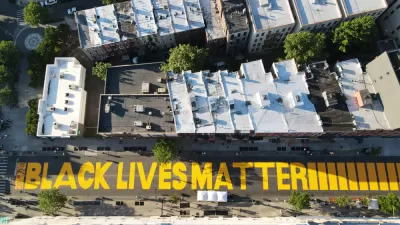At the CNU-FL statewide meeting held last week, Andrés Duany articulated his vision for how planning must adapt to the new realities of "national impoverishment" and climate change by utilizing the tools of tactical urbanism, writes Erin Chantry.
Acknowledging that two key issues that have emerged in the last five years - pervasive impoverishment from the Great Recession and the "psychological shifts of impending climate change" - have called into question the principles of New Urbanism that he had helped codify, Duany elucidated the tools that will be necessary for the changing practice of planning and urban design.
"Lean. Guerilla. Incremental. Vernacular. Tactical."
"On the other side of the economic downturn, or at least a good way through it," says Chantry, "Duany learned that the future of New Urbanism was in the ability for the organization and it’s professionals to be adaptable, incremental, and minimal. In other words, Duany said 'an urbanist does the least necessary and lets everyone else naturally do the rest.'”
He pointed to the transformation of the Wynwood Arts District in Miami as a prime example of the type of long-term change through small and short-term actions that's at the heart of the tactical urbanist movement. "The neighborhood’s ability to redevelop through adaption with small incremental change is an example of how our industry must shift to address the changing priorities of the future planning profession," notes Chantry.
As an avowed, but conflicted, New Urbanist, she, for one, is pleased with the tactical shift. "[B]y Duany proclaiming that his 'heavy, armored brigade' idea of urbanism (i.e., the rules, guides, and strict formulas) has become irrelevant, he has immediately made New Urbanism more relevant to my beliefs as an urbanist."
FULL STORY: The New, New Urbanism

Maui's Vacation Rental Debate Turns Ugly
Verbal attacks, misinformation campaigns and fistfights plague a high-stakes debate to convert thousands of vacation rentals into long-term housing.

Planetizen Federal Action Tracker
A weekly monitor of how Trump’s orders and actions are impacting planners and planning in America.

Chicago’s Ghost Rails
Just beneath the surface of the modern city lie the remnants of its expansive early 20th-century streetcar system.

Bend, Oregon Zoning Reforms Prioritize Small-Scale Housing
The city altered its zoning code to allow multi-family housing and eliminated parking mandates citywide.

Amtrak Cutting Jobs, Funding to High-Speed Rail
The agency plans to cut 10 percent of its workforce and has confirmed it will not fund new high-speed rail projects.

LA Denies Basic Services to Unhoused Residents
The city has repeatedly failed to respond to requests for trash pickup at encampment sites, and eliminated a program that provided mobile showers and toilets.
Urban Design for Planners 1: Software Tools
This six-course series explores essential urban design concepts using open source software and equips planners with the tools they need to participate fully in the urban design process.
Planning for Universal Design
Learn the tools for implementing Universal Design in planning regulations.
planning NEXT
Appalachian Highlands Housing Partners
Mpact (founded as Rail~Volution)
City of Camden Redevelopment Agency
City of Astoria
City of Portland
City of Laramie




























